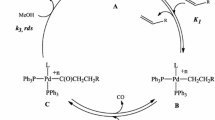Abstract
A combined chemical and mathematical approach was used to study the reduction process of 4-benzyloxy-4′-chlorochalcone involving catalytic transfer hydrogenation with ammonium formate and palladium on carbon. Several solvents were investigated to evaluate the effect of solvent-type on competitive reduction rates. A mathematical model based on Michaelis–Menten reaction kinetics was developed using a least squares approximation method to estimate several model parameters according to time-dependent reduction data. The conjugated alkene was found to reduce fastest in all solvents except alcohols, which is likely related to the solvent’s ability to support partially-charged intermediate species in the RDS of aryl chloride hydrogenolysis. Substrate concentration and pH dependence of the reduction were also investigated to confirm prior mechanistic findings. Hydrogen transfer from the formate to palladium appears to be rate determining in multiple reactions. Also, catalyst poisoning by HCl may affect aryl chloride reduction more significantly than reduction of other functionalities.






Similar content being viewed by others
References
Rajagopal S, Spatola AF (1995) J Org Chem 60:1347–1355
Anwer MK, Sherman DB, Rooney JG, Spatola AF (1989) J Org Chem 54:1284
Bar R, Sasson Y (1981) Tetrahedron Lett 22:1709
Wiener H, Blum J, Sasson Y (1991) J Org Chem 56:6145–6148
Groschuff E, Ber D (1903) Chem Ges 36(1783):4351
Brieger G, Nestrick TJ (1974) Chem Rev 74:567–580
Haertner H, Knotakte D (1980) J Mol Catal 1:3–10
Johnstone RAW, Wilby AH, Entwistle ID (1985) Chem Rev 85:129–170
Ram S, Ehrenkaufer RE (1988) Synthesis 91:5
Zini CA, vonHolleben MLA (1992) Quimica Nova 15:40–54
Rajagopal S, Anwer MK, Spatola AF (1994) Peptides : design, synthesis, and biological activity. Birkhäuser, Boston
Zheng C, Zhang J, Wang R (2004) Gongye Cuihua 12:29–35
Mehta NH, Manyar HG, Pawar NN, Gham NO (2004) Chem Indust Digest 17:55–60
Su C, Zheng C, Wang R, Zhang J (2004) Huaxue Tongbao 67:731–739
Fajt V, Kurc L, Cerveny L (2008) Int J Chem Kinet 40:240–252
Rajadhyaksha RA, Karwa SL (1986) Chem Eng Sci 41:1765–1770
Lo HS, Paulaitis ME (1981) Am Inst Chem Eng J 27:842–844
Fredenslund A, Jones RL, Prausnitz JM (1975) Am Inst Chem Eng J 21:1086–1099
Rautanen PA, Aittamaa JR, Krause AOI (2000) Ind Eng Chem Res 39:4032–4039
Cerveny L, Ruzicka V (1981) In Advances in Catalysis, 1st edn. Academic Press, New York
Cerveny L, Ruzicka V (1982) In catalysis reviews—science and engineering, 1st edn. Marcel Dekker, New York
Black JW, Leff P (1983) Proc R Soc London B202:141–162
Doktorov AB, Kipriyanov AA (2007). J Phys Condens Matter. doi:10.1088/0953-8984/19/16/065136
Oklno MS, Mavrovouniotis ML (1998) J Am Chem Soc 98:391–408
Glasser L (1979) J Chem Ed 56:22–23
Drougard Y, Decroocq D (1969) Bull Soc Chem Fr 9:2972–2983
Bernas A, Myllyoya J, Salmo T, Murzin DY (2008) J App Cat 353:166–180
Kohler Agnes Gamez Jochem, Bradley John (1998) Catal Lett 55:73–77
Blackmond Donna G (2005) Angew Chem Int Ed 44:4302
Mohrig JR, Hammond CN, Schatz PF, Davidson TA (2009) J Chem Ed 86:234–239
Goldberg R, Glen J (1994) Ind Eng Chem 33B:163–165
Keinam E, Greenspoon N (1986) J Am Chem Soc 108:7314
Nielsen SF, Kharazmi A, Christensen SB (1998) Bioorg Med Chem Lett 6:937
Sajiki H, Ikawa T, Yamada H, Tsubouchi K, Hirota K (2003) Tetrahedron Lett 44:171
Basu B, Bhuiyan MH, Das P, Hossain I (2003) Tetrahedron Lett 44:8931
Tian F, Lu S (2004) Syn Lett 39:1953–1956
Andrade CKZ, Silva WA (2006) Lett Org Chem 3:39–41
Kocienski PJ (2005) Protecting groups. Thieme, Munster
Rashad AA, El-Sabbagh OI, Baraka MM, Ibrahim SM, Pannecouque C, Andrei G, Snoeck R, Balzarini J, Mostafa A (2010) Med Chem Res 19:1025–1035
Robinson TP et al (2005) Mioorg Med Chem Lett 13:4007–4013
Rader CP, Smith HA (1961) J Am Chem Soc 84:1443–1449
MathWorks (2013) Matlab. vol R2013, Student Version edn
Ram S, Spicer LD (1992) Synth Commun 22:2683–2690
Suzuki S, Suzuki T (1965) Japanese J Sci Tech 38:2020
Kleiderer EC, Kornfield EC (1948) J Org Chem 13:455–458
Andrews MJ, Pillai CN (1978) Ind J Chem 16:465
Snyder LR (1978) J Chromatogr Sci 16:223–234
Maryott A, Smith E (1951) Dielectric constants of pure liquids. In: Linstrom PJ, Mallard WG (eds) NIST chemistry webBook, NIST standard reference database number 69. National Bureau of Standards, Washington, DC http://webbook.nist.gov
Li J-P, Zhang Y-X, Ji Y (2008) Selective 1,4-reduction of chalcones with Zn/NH4Cl/C2H5OH/H2O. J Chin Chem Soc 55:390–395
Acknowledgments
We would like to acknowledge Jeremy Martin, Tumare Iqbal, leaders/participants from the 2010 CWCS Teaching Guided-Inquiry Organic Chemistry Labs Workshop and C344 students from 2011-2013 for their valuable contributions to this work.
Author information
Authors and Affiliations
Corresponding author
Rights and permissions
About this article
Cite this article
Nguyen, T., Arciero, J., Piltz, J. et al. Kinetic study of competitive catalytic transfer hydrogenation on a multi-functional molecule: 4-benzyloxy-4′-chlorochalcone. Reac Kinet Mech Cat 111, 1–14 (2014). https://doi.org/10.1007/s11144-013-0627-5
Received:
Accepted:
Published:
Issue Date:
DOI: https://doi.org/10.1007/s11144-013-0627-5




